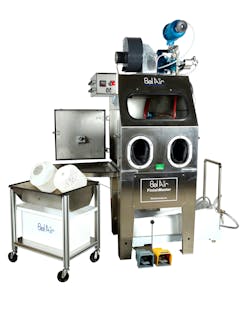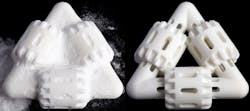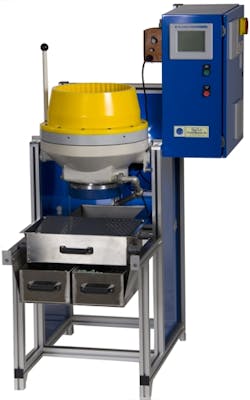Post-processing of laser additively manufactured metal and plastic parts

STEVE ALVITI
As laser additive manufacturing technologies progress, they are becoming an increasingly more viable form of production and prototyping. Laser additive manufacturing can produce multiple parts simultaneously and create complex geometries, making it a strong contender compared to more-traditional methods of manufacturing.
The two major types of laser additive manufacturing currently involve either melting powder within a powder bed layer by layer (direct-metal laser sintering and selective laser sintering) or directly melting powder by feeding it into a melting pool or using a wire feed (direct-metal deposition). These processes utilize mixtures of metal to create functional and aesthetic characteristics within parts. They also can create parts made of various metals and plastics such as stainless steel, aluminum, nickel, copper, cobalt, nylon, polyetherketoneketone (PEKK), and many others.
However, some core issues are often overlooked by manufacturers—specifically, post-processing these parts directly after the build. Often, when a part is removed from the build area, it still has small amounts of residual powder left within the structure and depending on the laser technology, it can have surfaces 3–20X the surface roughness of a machined part. Another issue is the cosmetic appeal of the part. To address the shortcomings of laser additive manufacturing, a post-process is often the best solution.
Post-process integration, types
When it comes to post-processing, it is necessary to determine how you want your post-process to plug into your production stream and the specific criteria each part needs. Plugging in a post-processing system into your production stream is no easy task—it should scale with the number of parts produced, as well as the size, geometry, and material composition of the parts. The part criterion is a set of standards that each part should adhere to. Specific surface roughness, a cosmetic look, and no residual build material are all example of criteria that can implemented using a post-process. Following this step, it is important to have general knowledge of the various technologies that are available to remove build material, deburr, polish, clean, plate, and dye parts.
Removing build material is often a necessity, especially when it comes to medical implants—contaminants must be removed or parts can potentially become deadly to patients. Water jet blasting is a technology that is often used to remove build materials from part surfaces, and water jet slurry blasting (FIGURE 1) is a wet surface treatment process that cleans, descales, and degreases in a single operation without chemicals or solvents. A mixture of water and abrasive media is used to treat a part’s surface by scrubbing rather than impinging and impacting. The Water Jet Blaster from Bel Air Finishing Supply (North Kingstown, RI) uses this process to treat surfaces (FIGURE 2) while also providing automation options in order to process batches of parts with the push of a button.Another noteworthy technology in this category is the Vibratory Bowl Finishers. These units are relatively inexpensive, but come in a wide array of shapes and sizes. They can also be equipped with a part feed system and internal part separation to further automate a post-process.
A third technology for deburring and polishing is the Drag Finisher. This technology is available in a variety of sizes as well and has extremely fast time cycles.
Parts often have contaminants, abrasives, mold supports, and even some build powder still left within their geometries even after being blasted. Cleaning parts is one of the methods available to remove these and provide the finishing touches to a build removal. Cleaning via ultrasonic removes contaminants that affect part functionality and is an effective way to prepare surfaces for dyeing/plating operations. These cleaning systems can even be purchased within a cleaning, drying, and dyeing cell, speeding up the final few steps of a post-process.
A post-process can also have coating and plating operations included as well—both metal and plastic parts can benefit functionally and cosmetically from these processes. This can involve adding plates of metal copper, nickel, silver, gold, or palladium and with a surface treatment, durability can be increased exponentially. Coating options are also available and come in a wide range of colors. These coating and surface technologies also help give products, designed for cutting and drilling, friction resistance and increase the overall lifespan of parts.
These technologies are all important to understand when considering a post-process for your laser additive manufacturing parts—however, media plays a crucial role as well. There are thousands of media available all with different abrasive compositions, shapes, materials, and applications. Selecting the right one is no simple task—fortunately, working with the right post-processing expert is a good way to narrow down your choices and select the right type.
Companies like Bel Air Finishing Supply know how to select the right media based on the physical and chemical make-up of parts. They can even point out the correct equipment to use in conjunction with media. This makes selecting the best media for your post-process easy and saves you the trouble of understanding how each different media affects parts.
Post-processing is beginning to gain more and more traction as the manufacturing world switches to newer forms of production. The newer forms of laser additive manufacturing come with many benefits—however, manufacturers need to mitigate the effects of their limitations. With post-processing, these effects can be eliminated or reduced to create a seamless flow of production while making the finished part look better than ever.
STEVE ALVITI([email protected]) is the President and Owner of Bel Air Finishing Supply, North Kingstown, RI; belairfinishing.com.
